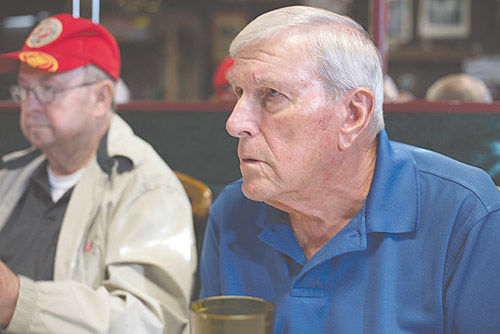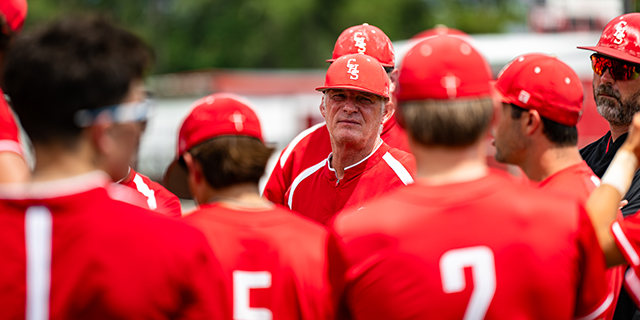Table Talk
Published 5:00 am Sunday, June 10, 2018

- Tracy Migues has participated in the New Iberia French Table since its inception, in 2010.
The French language is still spoken here
Trending
Preston Guillotte sat near the front of Victor’s Cafeteria one recent Thursday morning, his hands resting on a stack of books and papers — a Barron’s French-English Dictionary, a Dictionary of the Cajun Language, maps and postcards from France — as he conversed with several others in French.
For nearly a decade, Guillotte and a group of New Iberians have met every Thursday morning at 7 a.m. to speak French — the language many of them first learned at home but were discouraged from speaking in public as children. They are the local iteration of a more-than-twenty-year tradition taking place all across south Louisiana and extending even into Texas.
Opportunities Abound
The meetings are called French Tables. Each operates independently, with their own procedural rules and accepted varieties of the French language, but most have a “Captain,” or leading organizer.
Mike LeBlanc, a Lafayette-based French Table captain, maintains an evolving PDF directory of the groups. His own meets Friday afternoons at the Piccadilly Cafeteria on Johnston Street in Lafayette. There, participants speak freely, often breaking off into several conversations at once, and they are generally free to discuss whatever they fancy save for religion and politics. But at Abbeville’s Saturday morning French Table, at the Vermilion Parish Library, participants must be recognized by the chairperson before speaking.
A table that meets Tuesday afternoons at the Pamplona Tapas Bar in downtown Lafayette skews towards European French, while a Wednesday morning one that meets down the street, at Dwyer’s Cafe — the oldest French Table in South Louisiana, according to LeBlanc — hews more toward traditional Cajun French.
Trending
The largest of them meets in Arnaudville, and often includes music and cultural presentations. There are at least two tables in Rayne and in Baton Rouge, and at least one in New Orleans and in Thibodaux. There is even one in Houston, Texas.
Teche Area French Talkers
The New Iberia table is a more casual affair, a free-flowing, conversational mix of Cajun and European French with few rules except that, from 7 to 8 a.m., no English is allowed — though they have, on occasion, granted certain courtesies to that rule — say, for instance, if a nosy, non-French speaking reporter were to show, up asking questions. Merci beaucoup!
The French Table at Victor’s began in 2010, when New Iberia-native Rachel Gulotta — home for the summer from Davidson College, in North Carolina — was working for CODOFIL, the non-profit dedicated to local French immersion programs and the preservation of the French language in Louisiana. She told The Daily Iberian that year that colleagues had challenged her to start a chapter in town, so she first reached out to Guillotte.
“She talked to me about it, and we just went on from there,” Guillotte said. “It’s my first language, and I wanted to practice it.”
In 2013, Mathieu Despiau and Kilian Mourcou, from the French television show “Échappées Belles – Great Escapes,” visited the New Iberia table. Footage from Victor’s aired on French TV the following January.
Remembering His Roots
As a boy, Guillotte lived with his grandmother who, didn’t speak a word of English, he said.
“I didn’t learn English until I went to school,” he said. “We were all farm kids — none of us could speak English.”
He has since gotten into genealogy, tracing his lineage to his “genealogical cousins,” 10 generations and almost 250 years apart.
“They were on Prince Edward Island, after escaping British persecution in 1755,” he said. “Then the British came to the island in 1758, captured the Acadians there and expelled them to France. My ancestor was 12 years old — the only male survivor to make it back to France.”
But, Guillotte said, having tasted freedom and land ownership in the New World, they swore to return.
“In France, they had to go back to the old, sharecropping system, where the lords’ owned their property,” he said.
They returned to Louisiana in 1785, when his ancestor was 38-years-old. The Spanish were offering land to French refugees to help populate their territory, so his Acadians ancestors traveled by bayou from New Orleans to the Attakapas District, settling along the Bayou Teche.
“They’d had a taste of freedom in Nova Scotia,” he said. “They had their own property, and they wanted it again.”
Rogers Romero, seated at the table that Thursday morning in a red United States Marine baseball cap, has participated in the New Iberia French Table since its inception. His grandparents were also French speakers, but they refused to teach him and his siblings the language.
“They wouldn’t teach us French at all,” he said. “They were concerned about us being punished in school for speaking it.”
“We couldn’t speak English when we started school,” said Presley Landry, another long-time participant. “They’d paddle you if you spoke French in school.”
“The table has helped me to develop my vocabulary, and put that vocabulary into sentences and phrases. Now I can speak it. Not like them,” Romero said, nodding towards the others. “I’m still learning, but I think I’m doing pretty well.”
Guillotte said the table has never had less than five, averages between eight and ten and has had as many as 40 or more participants. Children in the French Immersion program at North Lewis elementary sometimes attend, taking up half the restaurant, he said. The group offers two annual scholarships of $1,000 each for select New Iberia Senior High School graduates that plan to take French courses in college.
“This year, we have one student who has studied French for 10 years, and we have another whose family is from Morocco, and she speaks fluent French,” Guillotte said.
There are currently more than 20 active French Tables on LeBlanc’s list, across the Cajun Coast and beyond.
“The way it happened was that the table at Dwyer’s wasn’t publicizing itself, so in 2004 or 2005 I started publicizing it, and then I started collecting a list of all the active tables,” he said. “Some tables would have spin-off groups, or I’d hear a report about a group and try to follow up. Some die out.” He estimates that his list is between 70 to 90 percent accurate at any given time.
“It makes us remember our childhoods. It’s a time for storytelling, remembering, gossiping,” he said.





